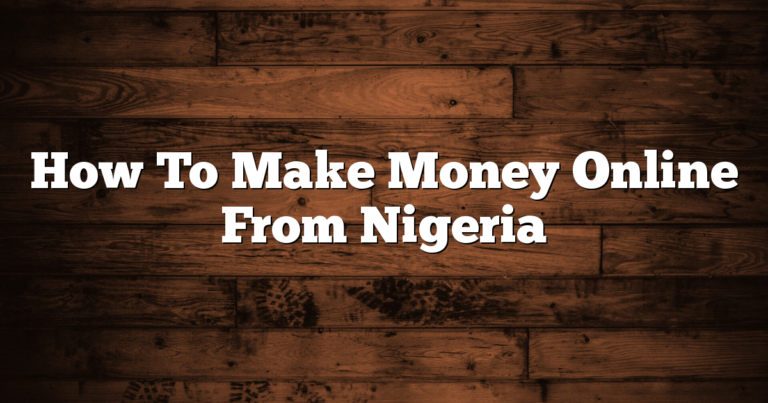How To Start Making Money Easily

Hey there, hustlers! Are you tired of scrolling through your social media feeds, watching others rake in the cash while you're left wondering how to start making money easily? Well, fret no more because I've got some insider tips and tricks to help you kickstart your moneymaking journey. Whether you're a tech-savvy teen or a seasoned adult, this article is your ultimate guide to turning your skills and passions into cold, hard cash. So, grab a cup of joe, sit back, and get ready to unlock the secrets of easy money-making!
Identifying profitable opportunities
Alright, let's dive into the world of identifying profitable opportunities! Now, when it comes to making money, it's all about finding those golden chances that can turn your pockets from empty to overflowing. So, how do we go about spotting these opportunities? Well, my friend, it's all about keeping your eyes peeled and your mind open.
First things first, you gotta stay informed. Stay up to date with the latest trends, news, and developments in the market. This could be anything from new technologies to emerging industries. By staying in the loop, you'll be able to spot potential gaps or niches that you can tap into. Remember, knowledge is power!
Next, it's time to do some good old-fashioned research. Dive deep into the market you're interested in and analyze the competition. Look for areas where you can offer something unique or better than what's already out there. It could be a new twist on an existing product or a completely fresh idea. The key is to find a gap in the market that you can fill with your own special sauce.
Lastly, don't be afraid to take risks. Sometimes, the most profitable opportunities are the ones that seem a little out of reach or unconventional. Don't be afraid to think outside the box and take a chance on something that others might overlook. Remember, fortune favors the bold!
So, my friend, keep your eyes open, do your research, and be willing to take a leap of faith. With these strategies in your back pocket, you'll be well on your way to identifying those profitable opportunities that can change your life. Good luck out there!
Developing a business plan
So, you're thinking about starting your own business, huh? That's awesome! But before you dive headfirst into the entrepreneurial world, you need to have a solid plan in place. And that's where developing a business plan comes in. It's like the blueprint for your business, outlining everything from your goals and strategies to your financial projections and marketing tactics. Trust me, it's a crucial step that can make or break your success.
First things first, let's talk about the importance of having a business plan. Think of it as your roadmap, guiding you through the twists and turns of the business world. It helps you clarify your vision and mission, identify your target market, and understand your competition. Plus, it's a great way to attract potential investors or secure funding from banks. Without a well-thought-out business plan, you're basically flying blind, and that's not a good look for any aspiring entrepreneur.
Now, let's get into the nitty-gritty of developing a business plan. Start by defining your business concept and determining your unique selling proposition. What sets you apart from the competition? What problem are you solving for your customers? Once you have a clear understanding of your business idea, it's time to dive into market research. This involves analyzing your target market, identifying your ideal customer, and understanding their needs and preferences. This information will help you tailor your products or services to meet their demands and stand out in the market.
Next up, it's time to outline your marketing and sales strategies. How will you promote your business and attract customers? Will you use social media, traditional advertising, or a combination of both? And don't forget about your pricing strategy. How will you price your products or services to remain competitive while still making a profit? These are all important considerations that should be addressed in your business plan. And of course, let's not forget about the financial aspect. You'll need to create a detailed financial forecast, including projected revenue, expenses, and cash flow. This will help you determine if your business idea is financially viable and if you'll need any additional funding to get started.
So, there you have it. Developing a business plan is a crucial step in starting your own business. It's like having a roadmap to success, guiding you through the ups and downs of entrepreneurship. By defining your business concept, conducting market research, outlining your marketing strategies, and creating a financial forecast, you'll be well on your way to turning your business dreams into a reality. Good luck, and remember, the sky's the limit!
Choosing the right business model
So, you're thinking about starting your own business, huh? That's awesome! But before you dive headfirst into the entrepreneurial world, you need to make sure you choose the right business model. Trust me, it can make or break your success.
First things first, let's talk about what a business model actually is. It's basically the blueprint for how your business will operate and make money. It's like the foundation of a house – if it's weak or flawed, the whole thing could come crashing down.
Now, there are several different types of business models out there, and the one you choose will depend on a variety of factors. Are you selling a physical product? Offering a service? Maybe you're thinking of starting an online business? Each of these requires a different approach.
One popular business model is the subscription-based model. Think Netflix or Spotify. Customers pay a monthly fee to access your product or service. This can be a great option if you have a product that people use regularly or if you offer a service that requires ongoing support.
Another option is the freemium model. This is where you offer a basic version of your product or service for free, but charge for additional features or premium content. It's a clever way to attract customers and then upsell them on the extras.
Lastly, there's the traditional retail model. This is where you sell physical products directly to customers, either in a brick-and-mortar store or online. It's a tried and true method, but it can be competitive and requires careful planning and execution.
So, when choosing the right business model, think about what you're offering, who your target audience is, and how you want to make money. Do your research, talk to other entrepreneurs, and don't be afraid to take risks. Remember, the right business model can set you up for success, so choose wisely!
Setting up a professional online presence
So, you want to set up a professional online presence, huh? Well, you've come to the right place! In this digital age, having a strong online presence is crucial for anyone looking to make a name for themselves or their business. It's like having your own virtual storefront that's open 24/7, allowing you to reach a global audience and showcase your skills, products, or services. But where do you start? Let's dive in and explore the key steps to help you establish a killer online presence.
First things first, you need a website. This is your online headquarters, the place where people can find all the information they need about you or your business. Think of it as your digital business card, but with a lot more pizzazz. Your website should be visually appealing, easy to navigate, and reflect your brand identity. You can use website builders like Wix or WordPress to create a professional-looking site without any coding knowledge. Don't forget to include important details like your contact information, a brief bio, and examples of your work or testimonials.
Next up, let's talk about social media. Love it or hate it, social media is a powerful tool for building your online presence. It's like the modern-day equivalent of word-of-mouth marketing, but on steroids. Choose the platforms that align with your target audience and start creating engaging content. Whether it's sharing behind-the-scenes glimpses of your work, offering valuable tips and insights, or simply showing off your personality, social media allows you to connect with your audience on a more personal level. Don't forget to interact with your followers, respond to comments, and join relevant conversations to build a loyal community.
Lastly, don't underestimate the power of search engine optimization (SEO). In simple terms, SEO is the process of optimizing your website so that it ranks higher in search engine results. Why is this important? Well, think about it – when was the last time you went beyond the first page of Google search results? Yeah, me neither. By implementing SEO strategies like using relevant keywords, creating high-quality content, and building backlinks, you can increase your chances of being discovered by potential clients or customers. It's like waving a big neon sign that says, “Hey, I'm here, and I'm awesome!”
So, there you have it – the key steps to setting up a professional online presence. Remember, it's not just about having a website or being active on social media. It's about creating a cohesive and authentic online identity that reflects who you are and what you have to offer. So, go ahead, put yourself out there, and let the digital world know that you mean business!
Creating a product or service offering
So, you want to create a product or service offering? Well, let's dive right in and explore the process step by step. First things first, you need to identify a problem or a need that your product or service can address. This is the foundation of your offering, so take your time and really think about what pain points you can solve for your target audience.
Once you have identified the problem, it's time to brainstorm ideas for your product or service. Get creative and think outside the box! Consider what features or benefits your offering could have that would make it stand out from the competition. Don't be afraid to take risks and try something new – innovation is key in today's fast-paced market.
After you have a solid idea, it's time to start developing your product or service. This may involve conducting market research, designing prototypes, or creating a minimum viable product (MVP) to test with potential customers. It's important to gather feedback throughout this process and make any necessary adjustments to ensure that your offering meets the needs and expectations of your target audience.
Once you have a fully developed product or service, it's time to launch it into the market. This may involve creating a marketing strategy, setting pricing, and determining distribution channels. Remember, the launch is just the beginning – you will need to continuously monitor and evaluate the performance of your offering, making improvements and adjustments as needed.
Creating a product or service offering is no easy task, but with careful planning and execution, you can create something truly remarkable. So, go ahead and take that first step – the world is waiting for your innovative solution!
Implementing effective marketing strategies
So, let's talk about implementing effective marketing strategies. Now, marketing is all about getting your message out there and attracting customers to your business. But it's not just about throwing a bunch of ads out into the world and hoping for the best. No, my friend, effective marketing requires careful planning, creativity, and a deep understanding of your target audience.
First things first, you need to define your goals. What do you want to achieve with your marketing efforts? Is it to increase brand awareness, drive sales, or maybe launch a new product? Once you have a clear goal in mind, you can start brainstorming ideas and strategies that will help you reach it.
Next, it's time to do some research. You need to know who your target audience is and what they want. What are their needs, desires, and pain points? This will help you tailor your marketing messages and tactics to resonate with them. You can gather this information through surveys, interviews, or even by analyzing data from your existing customers.
Now that you have a good understanding of your audience, it's time to get creative. Think outside the box and come up with unique and engaging ways to reach your target market. This could be through social media campaigns, influencer partnerships, or even experiential marketing events. The key here is to stand out from the crowd and grab your audience's attention.
Once you have your strategies in place, it's important to track and measure their effectiveness. This will help you identify what's working and what's not, so you can make adjustments as needed. Use analytics tools to monitor website traffic, social media engagement, and conversion rates. This data will provide valuable insights into the success of your marketing efforts and allow you to optimize your strategies for even better results.
So, there you have it – a brief overview of implementing effective marketing strategies. Remember, it's all about understanding your audience, getting creative, and constantly evaluating and adjusting your tactics. With the right approach, you'll be well on your way to marketing success.
Building a strong customer base
So, let's talk about building a strong customer base. Now, this is a crucial aspect of any business, my friend. You see, a customer base is like the foundation of a building. Without a solid base, the whole thing can come crashing down. And trust me, you don't want that to happen.
Now, the first thing you gotta do is understand your target audience. Who are they? What do they want? What makes them tick? You gotta get inside their heads, my friend. Once you know who you're dealing with, you can tailor your products or services to meet their needs. It's like speaking their language, you know? And when you speak their language, they'll be more likely to stick around.
Next up, you gotta provide top-notch customer service. I'm talking about going above and beyond, my friend. Treat your customers like gold. Be there for them when they have questions or concerns. Show them that you genuinely care about their satisfaction. And hey, if you mess up, own up to it and make it right. People appreciate honesty and integrity, my friend.
Lastly, you gotta keep your customers engaged. You can't just win them over and then forget about them. Nah, that's not how it works. You gotta stay on their radar, my friend. Send them regular updates, offer exclusive deals, and create a sense of community. Make them feel like they're part of something special. And hey, don't be afraid to ask for feedback. Your customers are your best source of information, my friend. Listen to them, learn from them, and watch your customer base grow.
Establishing a reliable payment system
So, let's talk about establishing a reliable payment system. Now, I know what you're thinking – why is this even important? Well, my friend, let me tell you, a reliable payment system is the backbone of any successful business. It's like the foundation of a house – without it, everything falls apart.
First things first, a reliable payment system ensures that your customers can easily and securely make payments for your products or services. Imagine this – you're all excited about buying that new pair of sneakers online, but when you go to make the payment, the system crashes or takes forever to process. Frustrating, right? Well, that's exactly why having a reliable payment system is crucial. It ensures a smooth and hassle-free experience for your customers, which in turn builds trust and loyalty.
Secondly, a reliable payment system also helps you as a business owner. It streamlines your financial processes, making it easier for you to keep track of your transactions, manage inventory, and analyze sales data. With a reliable payment system in place, you can focus on growing your business instead of worrying about whether or not your payments are going through.
Lastly, a reliable payment system opens up new opportunities for your business. It allows you to accept various payment methods, such as credit cards, mobile payments, and even cryptocurrencies. By offering multiple payment options, you can cater to a wider range of customers and increase your chances of making a sale. Plus, with the rise of e-commerce, having a reliable payment system is essential for expanding your business online.
So, my friend, don't underestimate the importance of establishing a reliable payment system. It's not just about making transactions – it's about creating a seamless experience for your customers, simplifying your financial processes, and unlocking new possibilities for your business. Trust me, investing in a reliable payment system will pay off in the long run.
Managing finances and tracking income
So, let's talk about managing finances and tracking income. Now, I know this might not be the most exciting topic for some people, but trust me, it's super important. I mean, who doesn't want to have a handle on their money, right? Plus, being able to track your income can really help you make smarter financial decisions and reach your goals faster.
When it comes to managing finances, there are a few key things to keep in mind. First off, you need to have a budget. Yeah, I know, budgeting can sound like a drag, but it's actually pretty empowering. It's all about knowing where your money is going and making sure you're spending it on the things that matter most to you. So, take some time to sit down and figure out your monthly income and expenses. Break it down into categories like rent, groceries, entertainment, and savings. This way, you can see exactly how much you have coming in and where it's all going.
Now, let's talk about tracking income. This is all about keeping tabs on how much money you're bringing in each month. It's not just about your salary or wages, but also any side hustles, freelance gigs, or passive income streams you might have. Tracking your income can help you see if you're making progress towards your financial goals or if you need to make some adjustments. Plus, it's a great way to stay motivated and celebrate your wins along the way.
So, how can you track your income? Well, there are a few different methods you can try. Some people like to use good old-fashioned pen and paper to jot down their income each month. Others prefer using spreadsheets or budgeting apps to keep everything organized. Find a method that works for you and stick with it. The key is to make it a habit and stay consistent. And hey, if you're feeling fancy, you can even set up automatic income tracking through your bank or financial apps. That way, you don't have to worry about manually inputting all those numbers.
In conclusion, managing finances and tracking income may not be the most thrilling topics, but they are essential for financial success. By creating a budget and tracking your income, you can gain control over your money and make informed decisions. So, take the time to sit down, crunch those numbers, and start taking charge of your financial future. You got this!
Scaling and expanding the business
So, you wanna take your business to the next level, huh? Well, buckle up, my friend, 'cause we're about to dive deep into the world of scaling and expanding your business. Now, scaling is all about growing your business without losing its essence, like a plant that keeps blooming without losing its roots. It's about finding ways to increase your revenue, customer base, and market presence while maintaining the quality and values that got you here in the first place.
One way to scale your business is by exploring new markets. Think about it like this: you've conquered your local turf, and now it's time to spread your wings and fly to new horizons. This could mean expanding to different cities, states, or even countries. But hold your horses, partner! Before you jump into uncharted territories, do your homework. Research the market, understand the local culture, and adapt your products or services accordingly. Remember, what works in one place might not work in another, so be ready to pivot and adjust your strategy.
Another way to scale your business is by diversifying your product or service offerings. You know what they say, don't put all your eggs in one basket. By expanding your range, you not only attract a wider customer base but also reduce the risk of relying too heavily on one product or service. It's like having a buffet instead of just one dish. Customers love options, and by giving them more choices, you increase your chances of making a sale. Just make sure your new offerings align with your brand and complement your existing products or services. You don't want to confuse your customers or dilute your brand identity.
Lastly, but certainly not least, don't forget about the power of technology. In this digital age, technology can be your best friend when it comes to scaling your business. From e-commerce platforms to social media marketing, there are endless tools and strategies at your disposal. Embrace the digital revolution and leverage it to reach a wider audience, streamline your operations, and enhance your customer experience. But remember, technology is just a tool. It's how you use it that makes all the difference. So, be strategic, be innovative, and most importantly, be authentic. After all, people still crave that human touch, even in the digital realm.
So, there you have it, my friend. Scaling and expanding your business is no easy feat, but with the right mindset, strategy, and a sprinkle of creativity, you can take your business to new heights. Just remember to stay true to your roots, explore new markets, diversify your offerings, and embrace the power of technology. Now go out there and conquer the world, one business expansion at a time!
Another post you might find useful is, How To Start Making Money On Etsy.
I've also written about How To Start Making Money On Ebay, so feel free to check that out, or bookmark it for later!






